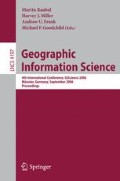Abstract
This paper presents a model for positional relations among bodies of arbitrary shape in three dimensions. It is based on an existing model for projective relations among regions in two dimensions. The motivation is to provide a formal qualitative spatial relations model for emerging 3D applications. Two sets of relations are defined: ternary projective relations based on the concept of collinearity between a primary object and two reference objects and quaternary projective relations based on the concept of coplanarity between a primary object and three reference objects. Four sets of JEPD relations are defined for points and bodies in R 3.
Access this chapter
Tax calculation will be finalised at checkout
Purchases are for personal use only
Preview
Unable to display preview. Download preview PDF.
References
Bartie, P.J., Mackaness, W.A.: Development of a Speech-Based Augmented Reality System to Support Exploration of Cityscape. Transactions in GIS 10(1), 63–86 (2006)
Bennett, B., et al.: Region-based qualitative geometry, University of Leeds, School of Computer Studies, LS2 9JT, UK. Technical Report 2000.07 (2000)
Billen, R., Clementini, E.: Introducing a reasoning system based on ternary projective relations. In: Developments in Spatial Data Handling, 11th International Symposium on Spatial Data Handling, Leicester, UK, pp. 381–394. Springer, Heidelberg (2004)
Billen, R., Clementini, E.: A model for ternary projective relations between regions. In: Bertino, E., Christodoulakis, S., Plexousakis, D., Christophides, V., Koubarakis, M., Böhm, K., Ferrari, E. (eds.) EDBT 2004. LNCS, vol. 2992, pp. 310–328. Springer, Heidelberg (2004)
Billen, R., Clementini, E.: Semantics of collinearity among regions. In: Meersman, R., Tari, Z., Herrero, P. (eds.) OTM-WS 2005. LNCS, vol. 3762, pp. 1066–1076. Springer, Heidelberg (2005)
Clementini, E., Billen, R.: Modeling and computing ternary projective relations between regions. IEEE Transactions on Knowledge and Data Engineering 18(6), 799–814 (2006)
Coxeter, H.S.M.: Projective Geometry, 2nd edn. Springer, New York (1987)
Freksa, C.: Using Orientation Information for Qualitative Spatial Reasoning. In: Frank, A.U., Campari, I., Formentini, U. (eds.) Theories and Models of Spatio-Temporal Reasoning in Geographic Space, pp. 162–178. Springer, Berlin (1992)
Gapp, K.-P.: From Vision to Language: A Cognitive Approach to the Computation of Spatial Relations in 3D Space. In: Proc. of the First European Conference on Cognitive Science in Industry, Luxembourg, pp. 339–357 (1994)
Hernández, D.: Qualitative Representation of Spatial Knowledge. LNCS (LNAI), vol. 804. Springer, Heidelberg (1994)
Klein, F.: Vergleichende Betrachtungen über neuere geometrische Forschungen. Bulletin of the New York Mathematical Society 2, 215–249 (1893)
Lewis, T., von Hohenbalken, B., Klee, V.: Common supports as fixed points. Geometriae Dedicata 60(3), 277–281 (1996)
Ligozat, G.F.: Qualitative Triangulation for Spatial Reasoning. In: Campari, I., Frank, A.U. (eds.) COSIT 1993. LNCS, vol. 716, pp. 54–68. Springer, Heidelberg (1993)
Scivos, A., Nebel, B.: The Finest of its Class: The Natural Point-Based Ternary Calculus for Qualitative Spatial Reasoning. In: Int. Conf. Spatial Cognition, pp. 283–303. Springer, Heidelberg (2004)
Wenger, R.: Progress in geometric transversal theory. In: Chazelle, B., Goodman, J.E., Pollack, R. (eds.) Advances in Discrete and Computational Geometry, pp. 375–393. Amer. Math. Soc., Providence (1998)
Zlatanova, S.: 3D GIS for Urban Development, University of Graz - ITC (2000)
Author information
Authors and Affiliations
Editor information
Editors and Affiliations
Rights and permissions
Copyright information
© 2006 Springer-Verlag Berlin Heidelberg
About this paper
Cite this paper
Billen, R., Clementini, E. (2006). Projective Relations in a 3D Environment. In: Raubal, M., Miller, H.J., Frank, A.U., Goodchild, M.F. (eds) Geographic Information Science. GIScience 2006. Lecture Notes in Computer Science, vol 4197. Springer, Berlin, Heidelberg. https://doi.org/10.1007/11863939_2
Download citation
DOI: https://doi.org/10.1007/11863939_2
Publisher Name: Springer, Berlin, Heidelberg
Print ISBN: 978-3-540-44526-5
Online ISBN: 978-3-540-44528-9
eBook Packages: Computer ScienceComputer Science (R0)

